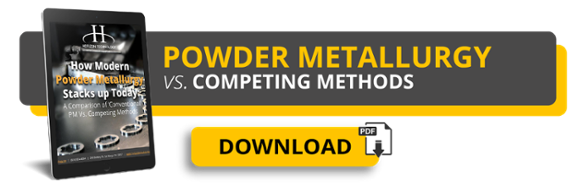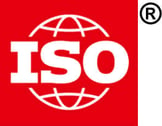Sometimes manufacturing moves faster than its customers. Methods of manufacturing metal powder that seemed unthinkable a decade ago are now suddenly part of the mainstream -- or so you hear.
Just when you thought you fully understood the benefits of powder metallurgy, along came its cousin, metal additive manufacturing, aka 3D printing.
Is it really possible to “print” perfect parts and eliminate some steps in the manufacturing process? Or is there a reason additive manufacturing remains a somewhat niche concept?
Here’s our weigh-in on the advantages and disadvantages of additive manufacturing processes vs. powder metallurgy of the “traditional” variety, including soft magnetic composites for electric motors.
Advantages and Disadvantages of Metal Additive Manufacturing Processes
What Is Additive Manufacturing?
(If you already know the basics of additive manufacturing, you can skip ahead to the “Where Does 3D Printing Fit With Powder Metallurgy?” section.)
As with any new technology, there are several pros and cons of additive manufacturing, depending on the specific technology used.
We could go on in great length about the different types of metal additive manufacturing, but there are only two types widely used in industry:
- Powder bed binder jetting (ink jet)
- Direct metal laser sintering (DMLS)
The metal additive manufacturing (AM) process is tool-less -- it uses powder to create a component in a way that resembles an inkjet printer. It breaks the part down into many 2D layers, and prints the finished component out layer by layer.
Ink Jet
Ink jet printing is a process that most resembles your traditional ink jet printer at home. We will discuss this technology in the most detail because at the time, although relatively slow, it’s by far the faster technology in the AM space.
- A thin layer of metal powder is spread across the entire build envelope.
- A print head moves across the print bed, which sprays a layer of binder in the shape of the desired part layer.
- Repeat steps 1 & 2 until the entire part is “printed.”
- Typically, the entire powder bed is moved into a thermal “binding” process, in which the binder that was sprayed on each layer is dried and gains its strength.
- The powder bed is moved into a de-powder station, where the loose powder is removed and the parts are cleaned.
- The parts are sintered. This is where the part shrinks by approximately 20% and gets its metallurgical bonds.
Direct Metal Laser Sintering
DMLS is a process that also works by creating a 3D part from many 2D layers.
- A very thin layer of powder is spread over the length of the build envelope.
- A laser beam moves across the layer, focusing on the areas that will form the part.
- The energy from the laser sinters the particles together on contact.
- The powder bed is moved into a de-powder station, where the loose powder is removed and the parts are cleaned.
Where Does 3D Printing Fit With Powder Metallurgy?
For many years, 3D printing has been helpful in the production of prototypes, but its shortcomings are evident when you need large quantities of quickly produced, low-cost items.
Additive manufacturing is finding its place in component manufacturing as a complement to injection molding and conventional pressing and sintering. Home or office versions of 3D printers use plastic to form the end part, but 3D printing can also be achieved in the industrial world using metal in powder form, similar to the powders used in powder metal compaction.
Are you making the decision to work with an additive manufacturing or PM (powder metallurgy) supplier? Whether it be for production or simply prototype parts, consider the pros and cons of both technologies.
Sure, it’d be neat to jump on board with this emerging technology, but does it really make sense? Or can you get a better overall experience with conventional powder metallurgy mixed with some advanced techniques and materials?
Additive Manufacturing Advantages
Metal additive manufacturing isn’t just technology for technology’s sake. There are indeed functional benefits of the additive manufacturing process
1. Rare Shape-Making Ability
Additive manufacturing is very attractive for unusual or complex component shapes that can be difficult to manufacture using other processes.
Design software makes it possible to create nearly any geometric form, such as:
- Hollow spaces
- Honeycomb filling
- Internal cooling channels
- Negative drafts
The possibilities from a design perspective are truly endless.
In this regard, think of 3D printing as powder metallurgy on steroids.
2. Manufacturing + Assembly in 1
An additive manufacturing line can produce multiple components at a time in the same build box. Instead of creating individual parts and assembling them at a later point (due to geometry constraints), an additive manufacturer can combine assemblies into single parts, which can reduce overall product cost in unique situations.
3. No Tooling Cost
With additive manufacturing, there is no up-front tooling cost like you’d see in traditional PM. This can also be a very attractive benefit to a low-volume production strategy.
Say you make your first prototypes, then test them out. What if you find you need a design change? Simply send a new model over to your AM supplier with the changes -- it’s that easy. The engineer can reload the model and be ready to start your next series of prototypes.
Additive Manufacturing Disadvantages
So, if it’s that easy, why would we ever not use AM??
Many of the benefits of additive manufacturing already exist in powder metallurgy, just in a more subtle form. You’ll have to decide whether modest improvements in those areas are worth the disadvantages associated with 3D printing:
1. Part Cost
Metal additive manufacturing has its benefits in cost when you need a run of 1-100 prototypes. Anything much beyond that, and the extreme “per-part” costs erode all the initial up-front tooling cost savings.
Depending on the part’s size, AM can be much as 5-100x the cost of a traditional powder metal part. This extreme cost is driven by two major factors: equipment use and material cost.
We’ll talk about equipment down below, but first, let’s get granular on the material cost.
Companies specifying materials for AM frequently look for very fine or small particle distribution. This can make the raw material cost of your project skyrocket -- even more so if the powder needs to be spherical. These particle shapes are produced from a gas atomization process used specifically in metal injection molding and powder bed binder jetting.
If the part can be pressed with traditional PM and machined later as necessary, there’s usually no reason to force AM into your manufacturing process.
2. Surface Finish
The surface finish capabilities for a 3D printed part have come a long way over the last decade. However, there are still two major challenges.
One is the overall finish capability of the additive manufacturing powder itself, which is very rough compared to traditional powder metal materials. The other is the layering effect inherent in AM part construction. This looks very similar to the topography of a map. When a height on an area of a part changes gradually while the cross-section grows inward or outward, a distinct layering effect occurs.
To solve this problem, manufacturers typically send their parts out for tumbling or electropolishing. This does a great job of blending the layers; however, the material removal creates an additional obstacle to controlling dimensional accuracy.
3. Dimensional Control
When processed through binder jetting, metal additive manufacturing has dimensional challenges similar to metal injection molding. Namely, the material shrinks by about 20% during sintering. So although printers are becoming more and more accurate, the sintering process can be a source of heartache.
Dimensional variation of ±0.5% can be expected within the same sintering batch. This means that the larger your design is, the more tolerance it must include.
Additionally, due to the shrinkage, parts experience extra friction during sintering. This causes circles to turn to ovals and overhangs to droop unless your manufacturer takes special care to design complex sintering fixtures.
4. No Custom Alloying
The mechanical properties of a finished product are dependent upon the characteristics of the powder with which you start.
Additive manufacturing typically uses a prealloyed material in the base powder. Why? There's no way to successfully introduce additional materials and traits later in the 3D printing process.
If your alloying material isn’t available yet from your supplier, you’re out of luck. All the materials and characteristics you want in your component have to be in the mix.
5. It’s Slow and Has Size Limitations
Industrial adaptation to additive manufacturing has been slow, and it’s still considered a niche process even in 2021. That’s because after all these years, AM is still not an efficient way of producing a high volume of parts.
Remember how we complimented AM’s ability to produce multiple parts at once? Good thing, because it’s otherwise a snail-like process relative to PM. Depending on your desired final shape and size, it can take 2-3 hours to produce a shape that conventional powder metallurgy could make in 5-10 seconds.
Even if speed is not a concern for you, depending on the type of 3D printing, there is a low ceiling when it comes to maximum part size.
For example: With binder jetting, you can print a part as big as the build box. However, successfully getting the part through the thermal binding, depowder, and sintering process without cracking or warping is another story. It can be done, but becomes extremely tricky and costly.
Unless your design is such a unique shape that there’s no other way it can be economically produced, it’s best to stay away from 3D printing. Even in cases where your design is a true unicorn, it may be better to adjust the shape rather than your manufacturing method.
3D Printing Soft Magnetic Composite Materials
So why didn't we address additive manufacturing of our favorite topic, soft magnetic composites (SMCs)? You may recall that these “superpowders” are coated with an electrically insulating film to offer better magnetic performance than, say, steel laminations.
The short answer is that the AM process is a long way from being able to handle SMCs. As we speak, we’re looking into material and process development around this issue.
The long answer?
When it comes to electric vehicle motor components, specifically stators and rotors, there are two driving forces in performance -- permeability and core loss. The density of the component drives permeability, and the insulation layer around SMCs reduces core losses.
To successfully 3D print a soft magnetic component such as this, the final product must be very dense, and the insulation layer can’t experience heat above 1000°F or so.
Although you can probably find someone who says they can 3D print soft magnetic composites, in reality the technology is not capable today. Binder jetting prints at very low densities -- the component doesn’t get its density boost until the sintering furnace. Consequently, the magnetic performance will end up substantially below what you expect from SMCs -- not even adequate for a prototype.
SMC parts can’t be sintered at high temperatures because the heat deteriorates the all-important insulation layer around each particle. Curing at temperatures around 1000°F ensures discrete particle separation. All densification must happen prior to curing.
One day it may be possible to prototype SMC components with additive manufacturing. However, it’s not today, and probably not next year either.
What's the Future of Metal 3D Printing (& Powder Metallurgy)?
Metal additive manufacturing companies are trying to become more competitive in areas beyond unique automotive parts. But in most cases, it still makes economic sense to use powder metallurgy to meet current and future parts manufacturing needs.
Remember, not all powder metal companies are using decades-old technologies and materials. Check out the resources below to see what conventional powder metallurgy suppliers are doing these days to compete with the advantages and disadvantages of 3D metal printing and other manufacturing processes:
- Beginner’s Look at High-Temperature Sintered Parts
- Powder Metal Materials: A Visual Flow Chart of Possibilities
The following articles give a more direct comparison powder metallurgy vs. die casting, forging, and other processes. Or, for an all-in-one look, download the free e-book below.
- Metal Injection Molding Vs. Powder Metallurgy the 'Old' Way
- Advantages of Powder Metallurgy Vs. Die Casting
- Powder Metal Vs. Forged Parts: Advantages & Disadvantages
- Soft Magnetic Composite Vs. Laminated Steel: Uses & Limitations
(Editor's note: This article was originally published in April 2019 and was updated. June 2021)




